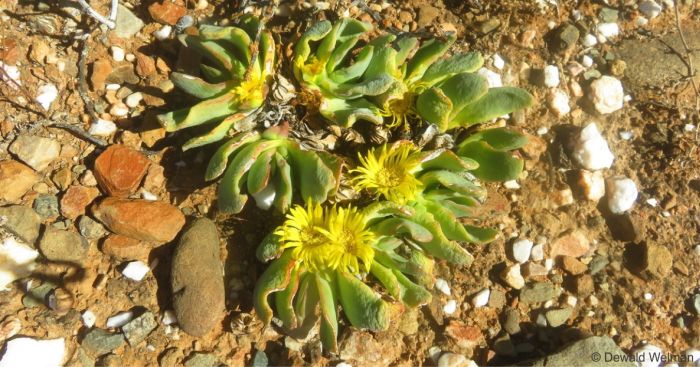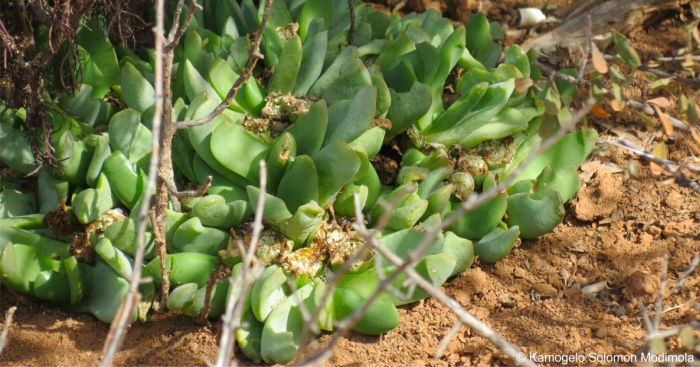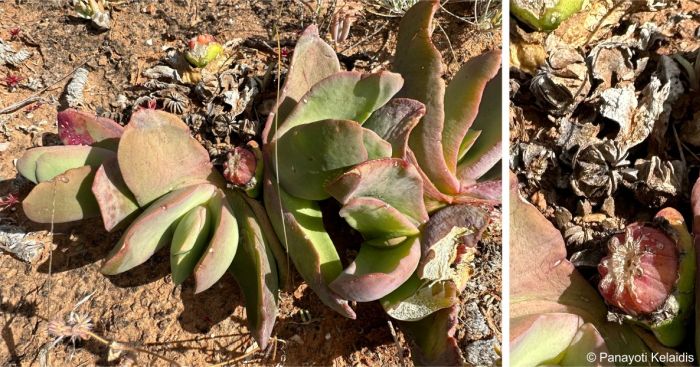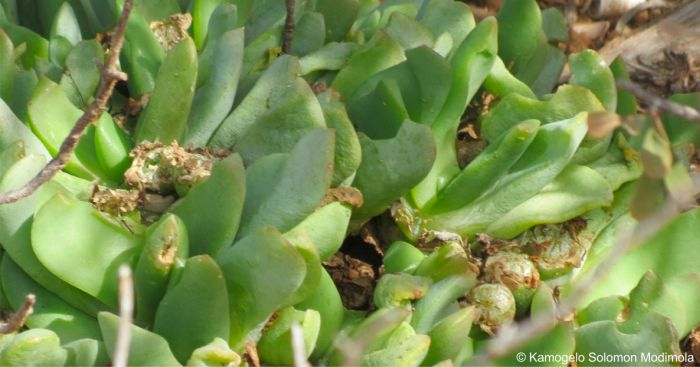Glottiphyllum carnosum
Glottiphyllum carnosum N.E.Br.
Family: Aizoaceae
Common names: fleshy tongue-leaf mesemb, fleshy tonguefig (Eng.); tongblaarvygie (Afr.)
Introduction
Occurring in a biome such as Succulent Karoo with very limited rainfall, the hardy yet fragile Glottiphyllum carnosum is adapted to withstand it all, with its toughest adversary being the Ostrich industry.

Description
Description
Glottiphyllum carnosum is a small, flat-growing succulent plant with leaves that range in colour from blue-green to yellow-green and have a smooth texture. It grows in clusters that can reach a diameter of up to 300 mm. The leaves are mostly almost upright and can measure up to 65 mm in length and 20 mm in width. The flowers, which appear between the leaves in late autumn and winter, are yellow and resemble daisies, with a diameter of approximately 25 mm.
Conservation Status
Status
Glottiphyllum carnosum is classified as a threatened species, and is assessed as Endangered (EN) on the SANBI Red List of South African Plants due to the significant threats it faces. The primary dangers to this plant are trampling and grazing. The Klein Karoo and Succulent Karoo regions are home to around 90% of the ostrich industry's production, making it the main area for ostrich product output. As a result, this puts additional pressure on Glottiphyllum carnosum, leading to its declining population and threatened status.

Distribution and habitat
Distribution description
Glottiphyllum carnosum occurs in the Succulent Karoo and Klein Karoo regions, with high occurrence between Calitzdorp and Oudtshoorn, in the Western Cape, covering an area of 550 km² where it prefers gravel flats and sandstone slopes. It typically grows alongside Glottiphyllum regium and Glottiphyllum cruciatum, often in the shade of taller shrubs. The Succulent Karoo is a semi-desert area that experiences a moderate climate influenced by the nearby ocean. Most of this biome is in regions with a single peak of rainfall during the winter, such as Namaqualand and the western Great Escarpment. However, the greater Little Karoo region, affectionately known as the Klein Karoo, receives precipitation throughout the year, and one of the few known locations of G. carnosum is found here. Unfortunately, the habitat quality of Glottiphyllum carnosum at four known locations is currently deteriorating due to the negative effects of ostrich farming. Additionally, the species is threatened by trampling and grazing.
Derivation of name and historical aspects
History
The genus name is derived from the Greek words glotta, which means ‘tongue’, and phyllon, which means ‘leaf’, and describes the shape of the leaves. The species name carnosum is from Latin and means ‘fleshy’, referring to its succulent nature.
The genus Glottiphyllum contains 16 species and is indigenous to South Africa, most notably the the Karoo region in the Northern, Western and Eastern Cape Provinces. They grow in slate, sandstone, and quartz-rich rocks and soils.
Ecology
Ecology
Glottiphyllum carnosum is primarily found in rocky areas, often growing in crevices or on rocky outcrops and slopes. This species is well-adapted to arid and semi-arid environments, as it has developed various mechanisms to survive in harsh conditions. One of the notable ecological features of this species is its ability to store water in its fleshy leaves and stems. This adaptation allows the plant to withstand periods of drought by utilizing the stored water reserves. Additionally, the thick, waxy cuticle on the leaves helps to reduce water loss through evaporation. It is also well-suited to its rocky habitat due to its shallow root system. The roots anchor the plant to the rocky substrate and absorb water efficiently from the surrounding soil or rock crevices.
In terms of reproduction, Glottiphyllum carnosum is primarily pollinated by insects. The plant produces daisy-like flowers that attract insects such as bees and flies. After successful pollination, the plant forms small capsules containing numerous tiny seeds. These seeds are dispersed by wind and raindrops. The capsules open when it rains and the seeds are splashed out, and some may fall into nearby crevices, where they can germinate and establish new plants. A capsule may become detached from the mother plant and get blown away by the wind to another location, to await the next rain event to release some seeds, thus allowing the plant to colonise new areas.

Uses
Use
Glottiphyllum carnosum is highly valued in horticulture and landscaping due to its distinctive appearance and ability to withstand drought conditions. It is commonly utilized as an ornamental plant in gardens, rockeries, and succulent collections, thanks to its visually appealing fleshy leaves and vibrant flowers. Its drought tolerance also makes it suitable for xeriscaping, a landscaping approach that emphasizes water conservation and the use of plants that can thrive in dry environments.
While there is limited documentation specifically on the cultural uses of Glottiphyllum carnosum, there have been reports suggesting potential medicinal properties associated with certain species within the Glottiphyllum genus. The leaves of these plants contain astringent sap, which can be extracted and applied to the gums of teething infants to provide relief. Moreover, the sap of certain Glottiphyllum species has been traditionally used to treat conditions such as oral thrush, cough, acne, and even fever. Additionally, some species of Glottiphyllum are utilized in the production of dyes and pigments, and in some cases, they are even considered edible.

Growing Glottiphyllum carnosum
Grow
The plants in this genus are relatively easy to cultivate. In their natural habitat, they experience their main growth period in late winter and enter a period of dormancy in spring and summer. However, in cultivation it is recommended to provide them with some water throughout the year to prevent their epidermis from breaking and causing unsightly scars. During the middle of summer to the end of winter, it is advisable to water them moderately, while keeping the soil almost dry when the plants are dormant. In spring and summer, water should be given minimally, only when the plant starts to shrivel. Although they can still grow in summer if given water, it is generally best to water them sparingly during this time. If you live in an area prone to frost, it is recommended to grow them in a well-ventilated greenhouse or conservatory, using well-drained sandy loam soil suitable for succulent plants. During summer, keep the plants cool and shaded, but provide maximum light for the rest of the year. It is important to note that these plants thrive in sunny locations, as insufficient sunlight may affect their ability to flower properly.
There are two approaches to growing glottiphyllums. The first involves allowing nature to take its course by using large pots and providing ample water, resulting in abundant green leaves. The second approach involves simulating their natural habitat by intentionally subjecting them to hot summer droughts, using small pots and firm loam to achieve a more slender appearance. Both methods can yield attractive results. Regardless of the approach chosen, it is recommended to treat them as late-winter growers. Their soft leaves make them susceptible to damage, and they may also be prone to mealybugs.
With regards to propagation, this plant can be propagated from both seeds and cuttings.
Seed propagation of Glottiphyllum plants is a relatively straightforward process. The seeds of Glottiphyllum are known to germinate easily and can be sown in autumn in its winter-rainfall habitat, or in early to mid-spring.It is possible to sow them at other times of the year as well, except in very hot weather in the summer. For successful germination, it is important to use well-drained soil and create a warm and humid environment. Do not sow the seeds too deep, as this may prevent them from germinating. Under optimal conditions, the seedlings will grow quickly. Once the seedlings reach a height of 3-5 cm, they can be transplanted into their permanent location.
Glottiphyllum plants can also be propagated through stem cuttings. This method is typically performed towards the end of summer. The cuttings should be taken from the stems and placed in a propagating case with a temperature ranging from 15-21°C. Stem cuttings have the advantage of remaining true to the species, whereas seeds from open pollinated plants in cultivation can be hybrids.
References
- The Encyclopedia of Succulents, Glottiphyllum carnosum N.E.Br. https://www.llifle.com/Encyclopedia/SUCCULENTS/Family/Aizoaceae/28023/Glottiphyllum_carnosum. Accessed 8 Jan 2024.
- Hulley, I.M., 2018. Medicinal ethnobotany of the Little Karoo, South Africa. Thesis, D.Phil in Botany, University of Johannesburg, Johannesburg.
- Jacobsen, H. 1960. A handbook of succulent plants: descriptions, synonyms, and cultural details for succulents othert than Cactaceae. Blandford Press, London.
- Kelaidis, P. 2023-09. Observation of Glottiphyllum carnosum, Calitzdorp area, Western Cape. iNaturalist. Online. https://www.inaturalist.org/observations/187224570.
- Manning, J. & Goldblatt, P. 2012. Plants of the Greater Cape Floristic Region 1: the Core Cape Flora. Strelitzia 29. South African National Biodiversity Institute, Pretoria.
- Modimola, K.S. 2022-08. Observation of Glottiphyllum carnosum, Gamkaberg, Western Cape. iNaturalist. Online. https://www.inaturalist.org/observations/131347098.
- Mucina, L., et al. 2006. Succulent Karoo Biome. In: L. Mucina & M. Rutherford (eds.), Vegetation map of South Africa, Lesotho and Swaziland. South African National Biodiversity Institute.
- National Agricultural Marketing Council. 2010. The South African ostrich value vhain; opportunities for black participation and development of a programme to link farmers to markets. NAMC (National Agricultural Marketing Council), Pretoria.
- Succulents Network, Glottiphyllum carnosum. https://succulentsnetwork.com/glottiphyllum-carnosum-care-guide-with-pictures/.Accessed 4 Jan 2024.
- Succulentwiki, 17 types of popular Glottiphyllum pictorial guide. https://asucculent.com/17-types-of-popular-glottiphyllum-pictorial-guide/. Accessed 12 Jan 2024.
- Vlok, J.H. & Raimondo, D. 2007. Glottiphyllum carnosum N.E.Br. National Assessment: Red List of South African Plants version 2020.1. Accessed on 2024/01/04.
- Welman, D. 2022-05. Observation of Glottiphyllum carnosum, Calitzdorp area, Western Cape. iNaturalist. Online. https://www.inaturalist.org/observations/115558797.
- World of Succulents, Glottiphyllum carnosum. https://worldofsucculents.com/glottiphyllum-carnosum/. Accessed 08 January 2024.
Credits
Yandisa Ndzeku
Kirstenbosch National Botanical Garden
February 2024
Acknowledgements: images by Kamogelo Solomon Modimola, Dewald Welman and Panayoti Kelaidis.
Plant Attributes:
Plant Type: Succulent
SA Distribution: Western Cape
Soil type: Sandy, Loam
Flowering season: Autumn, Winter
PH: Acid
Flower colour: Yellow
Aspect: Full Sun, Morning Sun (Semi Shade), Afternoon Sun (Semi Shade)
Gardening skill: Easy
Special Features:
Horticultural zones








Rate this article
Article well written and informative
Rate this plant
Is this an interesting plant?
Login to add your Comment
Back to topNot registered yet? Click here to register.